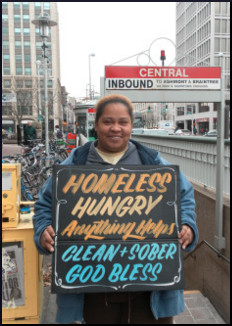
All year round, and especially during the annual or biannual count of people experiencing homelessness, outreach workers take on the job of informing people about their options. Maybe some street people don’t know that shelter is available, or what the requirements are. On the other side of the coin, some have had such negative experiences in shelters that they prefer to endure any other accommodations.
One school of thought that some people like to characterize as “tough love” but is more likely just callousness, holds that shelters are not supposed to be nice places. If the place is comfortable, lazy freeloaders will just stay forever. According to this world-view, the necessity to endure discomfort and indignity in a shelter is supposed to provide all the inspiration needed to encourage people to find a job and a home. If only it were that easy! If living under punitive conditions was all it took to turn people’s lives around and set them on the path to success, Skid Row would be full of millionaires.
Rules Are Rules…Which Can Be Bad for the Homeless
For housed people who don’t encounter these problems, it is tempting to go for the easy answer and think that shelter resistance stems from an unwillingness to follow the regulations. Certainly, there are individuals who prefer to live outside and stay inebriated rather than put up with a no-alcohol rule.
Unfortunately, strictures that sound reasonable on paper can be totally counterproductive for those who are fortunate enough to find work. What if the only shelter in the area closes down its sign-in process at 4:30 in the afternoon, and you have a job that ends at 5:00? What if it’s only a part-time gig, or even a full-time job at minimum wage? You still can’t afford to rent a place to live, and thanks to the sign-in time limit, you’re worse off than an unemployed homeless person because you’ll need to sleep outside. That’s “economic homelessness,” a situation in which far too many people find themselves.
A blogger known as “Moondustwriter” wrote about staying with her daughter in an apartment setup shared with another single mother:
This particular shelter didn’t have a soup kitchen. So on the two to maybe three hundred I would have a month, I would struggle to pay for food, basics (like clothes and toiletries) and transportation for two. Don’t get me wrong, I learned how to live on $300 a month but you don’t save any money to get your own place by living in a shelter.
If a person experiencing homelessness is lucky enough to have a job but works night shift, forget about the standard shelter. In some cities, if the weather is unbearably cold or hot, there may be a place where people can hang out during the day. But getting a proper sleep is out of the question.
Often, shelter “beds” are no more than mats on the floor. Sure, that’s probably better than frostbite, but keeping your fingers and toes can come at a high price, like catching tuberculosis from the person on the adjoining mat, or becoming infested with bedbugs, or being stepped on or vomited on by someone on the way to the toilet. There is a psychological price, too. A newly homeless person is in no position to be a snob, but life suddenly becomes full of people you would not consider for the role of bestie. Ted Heistman wrote:
It’s natural to seek rapport with the people you are hanging out with, but you want to avoid having dysfunction rub off on you too much. You don’t want to start thinking its normal to stink and be dirty and drunk or stoned all the time.
Balancing that disadvantage, some experienced people say that the motivated and upwardly bound homeless person will stand out. In a shelter, it’s possible that…
Only about 10 to 20% will be normal middle class type people that have found themselves in a bad situation. This is you. People will go out of their way to help you, even the other hard case homeless people might. So if you swallow your pride and accept the help, you may soon find yourself with a new place to live.
Reactions?
Source: “Homeless in America Creating More Tent Cities,” Financial -Market -News.com, 05/17/14
Source: “Shelters for the Homeless,” Moondustwriter.com, 02/18/14
Source: “How to be “Stealth” Homeless,” Disinfo.com, 10/25/12
Source: “7 Things No One Tells You About Being Homeless,” Cracked.com, 11/12/13
Image by Kenji Nakayama and Christopher Hope


